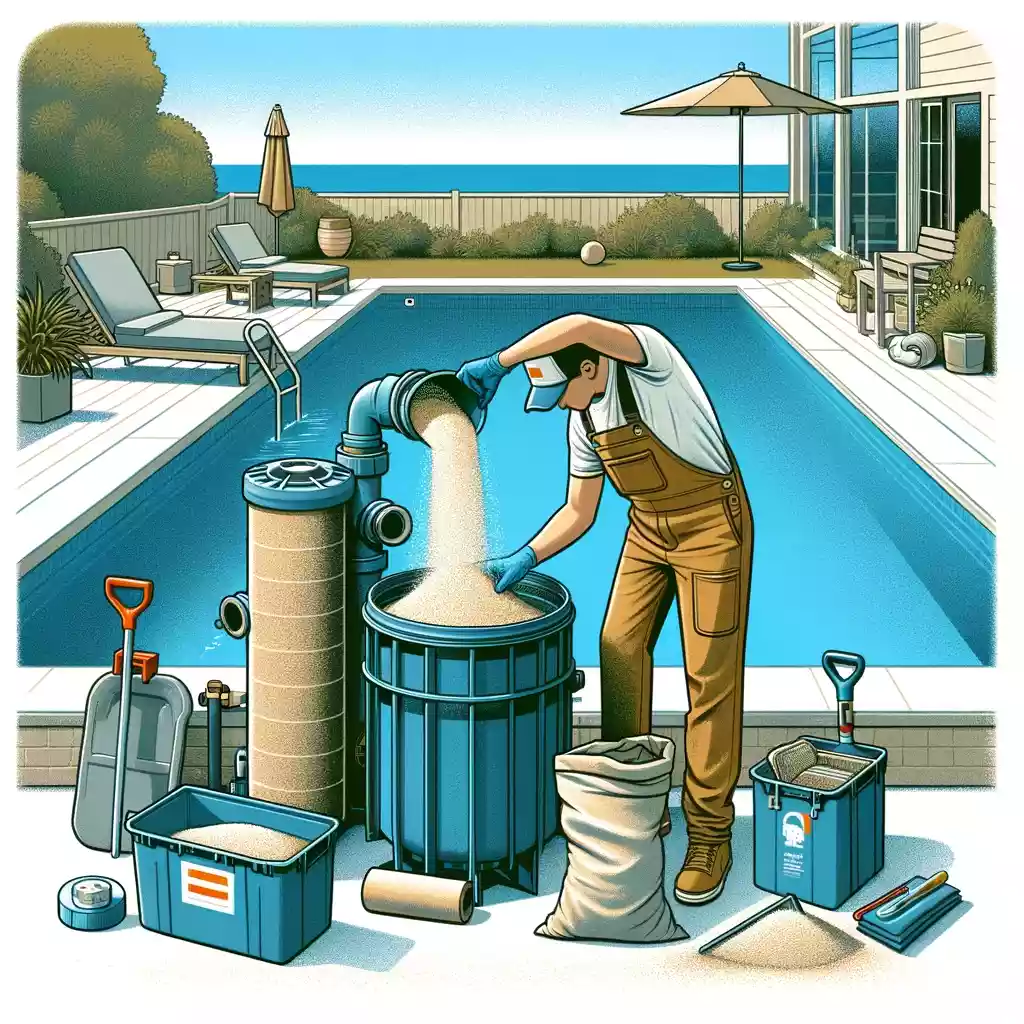The sand filter serves as the heart of any filtration system, playing an essential role. It is not only related to the clarity and hygiene of the water quality but also directly affects the operating costs and maintenance difficulty of the swimming pool. Therefore, correctly selecting the sand filter, properly starting it, and timely replacing the sand are crucial to ensuring the long-term stable water quality of the pool. This article will provide you with a comprehensive guide to the selection, startup, and sand replacement for sand filters, aiming to help you systematically understand this process and ensure you can effectively manage and maintain your swimming pool filtration system.
I. Selection of Sand Filters
1、Calculate Pool Water Volume
First, calculate the volume of the swimming pool with the formula “length x width x average depth.” This calculation indicates the pool’s water capacity, an important parameter when choosing a sand filter.
2、Determine Circulation Flow Q
Circulation flow Q refers to the total volume of pool water that needs to be filtered within a specified circulation period. The calculation is “pool water volume x 1.05 / circulation period (4 hours).” The “1.05” is a coefficient to ensure that the water is fully filtered.
3、Choose Filtration Speed
Filtration speed means the volume of water filtered per unit filter area per unit time. Typically, filtration speed is categorized into low-speed filtering (10m/h), medium-speed filtering (11-30m/h), and high-speed filtering (31-50m/h). In practice, the filtration speed for public pools should be less than 25m/h to ensure that the water quality meets sanitary, healthy, and clear standards.
4、Consider Filtration Efficiency and Pressure Loss
Experience shows that within the range of 10-25m/h, the filtration effect and the pressure loss of the filter are directly proportional to the filtration speed. If the filtration speed is too high, it will lead to a rapid decrease in filtration efficiency and deterioration of water quality.
II. Precautions When Starting the Use of Sand Filters
1、Pre-startup Checks
a) Before starting, adjust the multi-way valve of the sand filter to the filtration state, preparing to start the filtration work.
b) Check if all valves in the pipeline are in the correct state, ensuring normal water flow and system operation.
c) Inspect the hair collector for blockages; if any are found, clean them out first and check for any trapped air, which should be purged if present.
d) Ensure that the tank lid is tightly sealed and not leaking air. If there is a leak, tighten the lid to ensure a proper seal.
e) Check that each dosing system’s liquid medicine pipe is clear and unobstructed and that there is enough medicine in the medicine barrel. Also, make sure that the dosing device’s valves are open so the dosing system can work properly.
2、Startup Sequence
- Start by turning on one water pump motor; once it operates normally, sequentially start the other pumps. The backup pump does not need to be started.
- Record the pressure gauge readings on the filter to determine if backwashing is necessary.
- Observe the operation of the water pump to confirm it is running smoothly and without any unusual noise.
- Check that each dosing system is functioning correctly and that the medicine is being correctly dispensed.
- Visually inspect each water injection port by the poolside to ensure normal water discharge, confirming the water circulation system is unobstructed.
III. Precautions for Sand Replacement in Sand Filters

Sand Replacement Steps
a) Selecting Quartz Sand: Choose quartz sand with a hexahedral shape and eight edges, as this shape can create the right gaps for filtration.
b) Opening the Sand Tank: Open the sand filter and thoroughly clean out the old sand and debris.
c) Piling Quartz Sand: Evenly lay the new quartz sand within the sand tank. The gaps between the sand grains allow water to pass smoothly, trapping particles larger than the gaps, thus achieving the purpose of filtration. The size of the gaps affects filtration precision; too small gaps may reduce water output and efficiency.
d) After Laying the Sand: Once the quartz sand has been laid, reattach the sand tank cover, ensuring good sealing to prevent leaks.
Precautions When Changing Sand
- Protect the Pump: Before changing the sand, cover the pump with waterproof materials such as plastic sheeting to prevent water from entering the pump and causing damage.
- Protect the Central Pipe: When adding quartz sand, seal the opening of the central pipe with tape to prevent sand from entering the interior.
- Washing Quartz Sand: Wash the new quartz sand before adding it to the tank, starting with a forward wash followed by a backwash. During backwashing, keep an eye on the pressure gauge; if pressure exceeds 3kg, switch back to forward washing immediately.
- Filling Volume: The volume of quartz sand should not exceed 70% of the tank’s total volume to leave enough space for backwashing.
- Using Raw Water Pump for Cleaning: Tap water pressure may not be sufficient to thoroughly clean the quartz sand unless the raw water pressure is high enough. Otherwise, use the raw water pump for cleaning.
We hope these guidelines assist you in maintaining a clean pool and ensuring swimmers enjoy a safe and refreshing swimming experience. If you have any questions or need further assistance, we recommend consulting us for more personalized services and advice.
